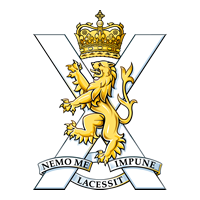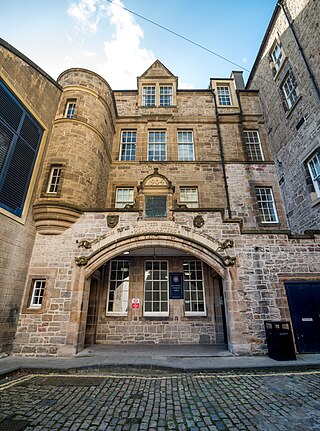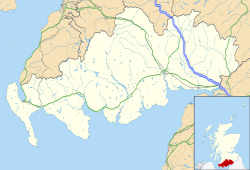
Dumfries is a market town and former royal burgh in Dumfries and Galloway, Scotland, near the mouth of the River Nith on the Solway Firth, 25 miles (40 km) from the Anglo-Scottish border. Dumfries is the county town of the historic county of Dumfriesshire.

The King's Own Scottish Borderers (KOSBs) was a line infantry regiment of the British Army, part of the Scottish Division. On 28 March 2006 the regiment was amalgamated with the Royal Scots, the Royal Highland Fusiliers, the Black Watch, the Highlanders, the Argyll and Sutherland Highlanders, 52nd Lowland Regiment, and 51st Highland Regiment to form the Royal Regiment of Scotland. However, after just a few months the battalion merged with the Royal Scots Battalion to form the Royal Scots Borderers.

The 52nd Lowland Volunteers is a battalion in the British Army's Army Reserve or reserve force in the Scottish Lowlands, forming the 6th Battalion of the Royal Regiment of Scotland, also known as 6 SCOTS. Due to its erstwhile association with the 1st Regiment of Foot, it is the senior Reserve line infantry battalion in the British Army. It is one of two Reserve battalions in the Royal Regiment of Scotland, along with 51st Highland, a similar unit located in the Scottish Highlands.

The Scottish Division was a British Army Infantry command, training and administrative apparatus designated for all Scottish line infantry units. It merged with the Prince of Wales' Division, to form the Scottish, Welsh and Irish Division in 2017.

The Royal Regiment of Scotland (SCOTS) is the senior and only current Scottish line infantry regiment of the British Army Infantry. It consists of three regular and two reserve battalions, plus an incremental company, each formerly an individual regiment. However, three regular battalions maintain their former regimental pipes and drums to carry on the traditions of their antecedent regiments.
The 5th Kirkcudbrightshire Rifle Volunteers Football Club was a football team based in Dumfries, Scotland.
The 155th Brigade was an infantry brigade of the British Army that saw active service in both the First and the Second World Wars. Assigned to the 52nd (Lowland) Division, the brigade saw active service in the Middle East and on the Western Front during the First World War. During the Second World War, now the 155th Infantry Brigade, it continued to serve with the 52nd Division in Operation Dynamo, and later in North-western Europe from late 1944 until May 1945.
The 65th Division of the British Army was a second-line Territorial Force division, formed in 1914, which served on home defence duties during the First World War.

Hepburn House, also known as East Claremont Street Drill Hall, is a military installation in Edinburgh.

The Forrest Hill drill hall is a former military installation in Edinburgh, Scotland. The building is now owned by the University of Edinburgh.

The Titchfield Street drill hall is a former military installation in Kilmarnock.

The Paton Street drill hall is a military installation in Galashiels, Scotland.

The Bank Street drill hall is a former military installation in Brechin, Scotland.

The Ferry Road drill hall, known locally as Seaforth Barracks, is a military installation in Dingwall, Scotland.

The Old Bank Road drill hall is a military installation in Golspie, Scotland.

The Cooper Park drill hall is a former military installation in Elgin, Scotland.

The Kinneskie Road drill hall is a former military installation near Banchory, Scotland.

The Rose Street drill hall was a military installation in Inverness, Scotland.

The Phoenix Street drill hall is a former military installation in Lancaster, Lancashire.
The 5th King's Own Scottish Borderers Football Club was a football team based in Dumfries, Scotland.

















